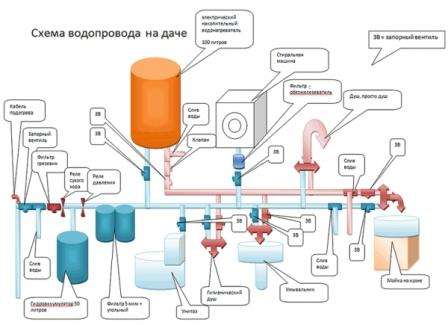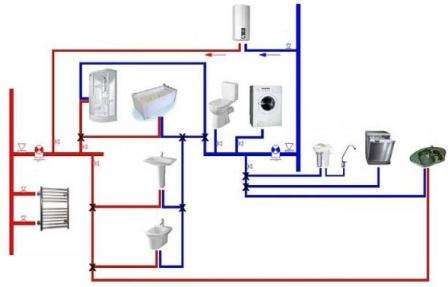
Every person today strives for comfort, so it is difficult to imagine a country house without water. The water supply of the house differs in schemes, however, the main water supply system is the same. We offer to understand water supply system wiring diagrams and choose the most suitable for your home or summer cottage.
Types of connection of water supply systems
The connection can be serial or parallel. Each of them is powered by a central line, or from a well (well).
 Pipe routing diagrams
Pipe routing diagrams
The serial connection is ideal for small households. With such a connection, the pipeline connects the water consumers, so the water goes to each one in turn. From the source, the pipeline is led to the consumer. A tee with one inlet and two outlets is mounted. It connects the primary consumer with others.
The parallel type of connection is more complex, but suitable for any type of housing, regardless of the number of residents and the size of the house. In this scheme there is a collector from which wiring is conducted to all consumers separately.
 Horizontal parallel piping
Horizontal parallel piping
In either method, the component of the systems is the same. The catchment comes from the mainline or from a well or a well. For a well (well), a booster pumping station, a storage tank (hydraulic accumulator) and filters are required.
Step-by-step instructions for installing a water supply system
After the tank, a tee with a shut-off type of fittings is mounted. The outlet at the tee is connected to pipes for household needs in the yard, the other to the domestic water supply. Water filters are inserted at the outlet of the water supply. After that, another similar tee is mounted. It shares hot water with cold water.

The cold water pipe is connected to a similar collector. Outlets are supplied with shut-off valves. The hot water pipe is connected to the boiler, boiler. Then she reaches for a similar collector.

When a question arises, where exactly to get water. In addition to the standard water supply, there are two options, this is a well or a well. The well can have a depth of 10 – 15 meters, the well can be up to 30 meters. When using well water, filters are installed on the system for coarse and subsequent fine cleaning.
The well must be equipped with a special pumping station.
The downhole water supply system is:
- submersible pump or station,
- nipple,
- check valve that prevents water from leaving back,
- pipeline,
- locking mechanism (fittings),
- thin filter type, quintuple (automatic connection),
- pressure gauge,
- pressure switch,
- hydroaccumulator.
Also read: How to install a pumping station
To install any system, you need to calculate the length and diameter of the required pipe. For the calculation, the length of the pipe in the whole house is taken. If the pipeline has a length of 15 – 20 meters, a diameter of up to 20 millimeters, 30 meters, 25 millimeters is suitable. If the length of the pipes is longer, 32 mm is taken.
 Well water supply
Well water supply
The manifold pipe is also calculated. For one tap, the water consumption per minute is 5 liters. Each consumer is counted and added. At 30 liters per minute, a pipe with a diameter of 25 millimeters is required. For 50 liters, 32 millimeters is suitable, for 75 liters it is 38 millimeters. If you have a large family or high water consumption, 40 percent is added to the calculation..
When the size of the pipes is calculated, the emphasis is on the material. Pipes can be made of metal-plastic, copper, steel, cross-linked polypropylene. All materials have their pros and cons. Copper is durable and does not rust, but it has a high price.
 Plumbing inside the house
Plumbing inside the house
Metal-plastic is an aluminum pipe with double-sided polypropylene coating, does not rust, does not deteriorate when exposed to light, impurities in water, does not accumulate deposits, but is not suitable for water with 95 degrees.

For a well or well water supply, this is the best option. Steel has one drawback and it is susceptible to corrosion. All individual elements must have threads or special connections.
Polypropylene materials are inexpensive and durable. To connect them, you need a special soldering iron (welding). For hot water, pipes must have a layer of aluminum, fiberglass.

Interesting article: Plumbing from a well
The movement of the installation starts from the source itself and goes to the consumers. When water supply to housing from a well (well), a pump is inserted inside or from above. The pipe is connected to the pump with a clamp or, if there is a thread, with its help. Thread is more commonly used for central water supply.
Then the water supply system is laid to the house and the storage tank, if there is no accumulator, then it is simply introduced into the room. A tee with a shut-off type of fittings is installed behind the tank. From the first exit, the pipeline goes to the water heater. From the second, to the cold collector. From the water heater to the hot water manifold. From them comes the wiring of the system. Meter, pressure gauge is installed by the water supply service.
Watch the video: Plumbing in a private house. Scheme. pad.
When routing through the wall, a glass is used. When wiring in a house, the distance of the pipe from the wall should be 25 centimeters. If there are drain taps, a slope is made to the side. For the storage tank, the crane also goes with the same slope..
Also read: How to arrange a flower garden near the house, photo
When outlining the corner from the outside, an allowance of 1.5 centimeters is made, when bypassing inside 4. The pipes are fastened with double and single clips. The distance is 2 meters. When using a soldering iron, the pipes are cut with special scissors to the desired length. The incision must be perpendicular.

The depth of the future adhesion is marked on the pipeline by 1.5 centimeters. Places for soldering are degreased with alcohol. A suitable nozzle is put on the soldering iron and heats up to working condition (260 degrees).
A heated nozzle is put on the pipes. The countdown is 6 seconds. The nozzle is removed. Pipes or fitting and pipe are connected. The plumbing is ready. Now you know how the pipeline is laid and you can do all the work with your own hands or with the involvement of specialists.
